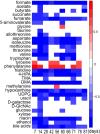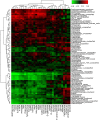Correlations of Fecal Metabonomic and Microbiomic Changes Induced by High-fat Diet in the Pre-Obesity State
- PMID: 26916743
- PMCID: PMC4768318
- DOI: 10.1038/srep21618
Correlations of Fecal Metabonomic and Microbiomic Changes Induced by High-fat Diet in the Pre-Obesity State
Abstract
Obesity resulting from interactions of genetic and environmental factors becomes a serious public health problem worldwide with alterations of the metabolic phenotypes in multiple biological matrices involving multiple metabolic pathways. To understand the contributions of gut microbiota to obesity development, we analyzed dynamic alterations in fecal metabonomic phenotype using NMR and fecal microorganism composition in rats using pyrosequencing technology during the high-fat diet (HFD) feeding for 81 days (pre-obesity state). Integrated analysis of these two phenotypic datasets was further conducted to establish correlations between the altered rat fecal metabonome and gut microbiome. We found that one-week HFD feeding already caused significant changes in rat fecal metabonome and such changes sustained throughout 81-days feeding with the host and gut microbiota co-metabolites clearly featured. We also found that HFD caused outstanding decreases in most fecal metabolites implying enhancement of gut absorptions. We further established comprehensive correlations between the HFD-induced changes in fecal metabonome and fecal microbial composition indicating contributions of gut microbiota in pathogenesis and progression of the HFD-induced obesity. These findings provided essential information about the functions of gut microbiota in pathogenesis of metabolic disorders which could be potentially important for developing obesity prevention and treatment therapies.
Figures



Similar articles
-
High-fat diet induces dynamic metabolic alterations in multiple biological matrices of rats.J Proteome Res. 2013 Aug 2;12(8):3755-68. doi: 10.1021/pr400398b. Epub 2013 Jun 27. J Proteome Res. 2013. PMID: 23746045
-
Antibiotics-induced perturbations in gut microbial diversity influence metabolic phenotypes in a murine model of high-fat diet-induced obesity.Appl Microbiol Biotechnol. 2019 Jul;103(13):5269-5283. doi: 10.1007/s00253-019-09764-5. Epub 2019 Apr 24. Appl Microbiol Biotechnol. 2019. PMID: 31020379
-
Short Term High Fat Diet Induces Obesity-Enhancing Changes in Mouse Gut Microbiota That are Partially Reversed by Cessation of the High Fat Diet.Lipids. 2017 Jun;52(6):499-511. doi: 10.1007/s11745-017-4253-2. Epub 2017 Apr 20. Lipids. 2017. PMID: 28429150
-
Beneficial Effects of Dietary Polyphenols on High-Fat Diet-Induced Obesity Linking with Modulation of Gut Microbiota.J Agric Food Chem. 2020 Jan 8;68(1):33-47. doi: 10.1021/acs.jafc.9b06817. Epub 2019 Dec 27. J Agric Food Chem. 2020. PMID: 31829012 Review.
-
Contribution of diet to gut microbiota and related host cardiometabolic health: diet-gut interaction in human health.Gut Microbes. 2020 May 3;11(3):603-609. doi: 10.1080/19490976.2019.1697149. Epub 2020 Jan 21. Gut Microbes. 2020. PMID: 31964203 Free PMC article. Review.
Cited by
-
Isoxanthohumol, a hop-derived flavonoid, alters the metabolomics profile of mouse feces.Biosci Microbiota Food Health. 2020;39(3):100-108. doi: 10.12938/bmfh.2019-045. Epub 2020 Feb 21. Biosci Microbiota Food Health. 2020. PMID: 32775127 Free PMC article.
-
Resistant Starch-Encapsulated Probiotics Attenuate Colorectal Cancer Cachexia and 5-Fluorouracil-Induced Microbial Dysbiosis.Biomedicines. 2024 Jun 28;12(7):1450. doi: 10.3390/biomedicines12071450. Biomedicines. 2024. PMID: 39062024 Free PMC article.
-
Microbiome and metabonomics study of quercetin for the treatment of atherosclerosis.Cardiovasc Diagn Ther. 2019 Dec;9(6):545-560. doi: 10.21037/cdt.2019.12.04. Cardiovasc Diagn Ther. 2019. PMID: 32038944 Free PMC article.
-
Early life gut microbiota is associated with rapid infant growth in Hispanics from Southern California.Gut Microbes. 2021 Jan-Dec;13(1):1961203. doi: 10.1080/19490976.2021.1961203. Gut Microbes. 2021. PMID: 34424832 Free PMC article.
-
GPR55 Antagonist CID16020046 Attenuates Obesity-Induced Airway Inflammation by Suppressing Chronic Low-Grade Inflammation in the Lungs.Int J Mol Sci. 2024 Jul 4;25(13):7358. doi: 10.3390/ijms25137358. Int J Mol Sci. 2024. PMID: 39000464 Free PMC article.
References
-
- Ogden C. L., Carroll M. D., Kit B. K. & Flegal K. M. Prevalence of obesity in the United States, 2009–2010. NCHS data brief. 1–8 (2012). - PubMed
-
- Finkelstein E., Fiebelkorn I. C. & Wang G. J. The costs of obesity among full-time employees. Am J Health Promot 20, 45–51 (2005). - PubMed
-
- Zhao W. et al. Economic burden of obesity-related chronic diseases in Mainland China. Obes Rev 9, 62–67 (2008). - PubMed
-
- Flegal K. M., Graubard B. I., Williamson D. F. & Gail M. H. Excess deaths associated with underweight, overweight, and obesity. J Am Med Inform Assoc 293, 1861–1867 (2005). - PubMed
Publication types
MeSH terms
LinkOut - more resources
Full Text Sources
Other Literature Sources
Medical

